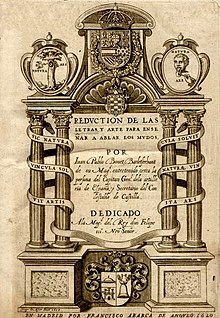History of sign language
[2][3][4][5] In Native American communities prior to 1492, it seems that Plains Indian Sign Language existed as an extensive lingua franca used for trade and possibly ceremonies, story-telling and also daily communication by deaf people.
[citation needed] The earliest concrete reference to sign language in Britain is from the wedding of a deaf man named Thomas Tillseye in 1575.
Martha's Vineyard, an island in Massachusetts, USA was settled by people carrying a gene causing deafness in the late 17th century.
In Europe, Aristotle and other prominent philosophers[13] believed that deafness was intrinsically connected to mutism and lack of intelligence, which was codified in Roman law; therefore they were considered incapable of being educated.
[14] When John of Beverley, Bishop of York, taught a deaf person to speak in 685 AD, it was deemed a miracle, and he was later canonized.
In France and the United States, sign language, or "manualism" was initially the favored communication method for education of deaf students, firmly supported by Clerc and therefore Gallaudet.
[16] In England and Germany oralism was considered to be superior - sign language was thought to be a mere collection of gestures, and a barrier between deaf people and hearing society.
At this meeting they passed a resolution removing the use of sign language from deaf education, and establishing the solely oralist classroom as standard.
Wyatte C. Hall says that sign language is important for the development of deaf children growing up because without it, they could be at risk of many health difficulties.
A study showed that there is an "age of acquisition" that affects adults' ability to understand grammar based on when they were introduced to sign language.
